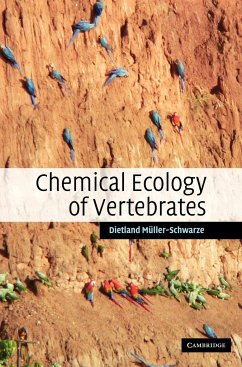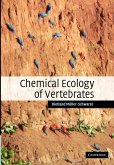Chemical Ecology of Vertebrates explores the chemically-mediated interactions between vertebrates and other animals and plants.
Chemical Ecology of Vertebrates is the first book to focus exclusively on the chemically-mediated interactions between vertebrates including fish, amphibians, reptiles, birds and mammals, and other animals and plants. Reviewing the latest research in three core areas - pheromones (where the interactions are between members of the same species), and interspecific interactions involving allomones (where the sender benefits) and kairomones (where the receiver benefits), it pulls together information from widely scattered technical literature in many different disciplines into a coherent whole. Chapters on the environment, properties of odour signals and production and release of chemosignals set the stage for discussion of more complex behavioural topics. While the main focus is ecological, dealing with behaviour and interactions in the field, it also covers chemoreception, orientation and navigation, the development of behaviour and the practical applications of chemosignals.
Review quote:
"This is an interesting book for anyone with even a passing interest in chemical ecology.... raises awareness and whets the appetite."
Gordon Hamilton, Bulletin of the British Ecological Society
Table of contents:
1. The odorsphere: the environment for transmission of chemical signals; 2. Properties of vertebrate semiochemicals; 3. Odor production and release; 4. Chemical cues in orientation and navigation; 5. Chemoreception; 6. Signaling pheromones; 7. Priming pheromones; 8. Development of intra- and interspecific chemical interactions; 9. Chemical defense by animals; 10. Herbivores' exposure to chemical defenses of plants; 11. Kairomones and synomones; 12. Practical applications of semiochemicals; Glossary; References.
Chemical Ecology of Vertebrates is the first book to focus exclusively on the chemically-mediated interactions between vertebrates including fish, amphibians, reptiles, birds and mammals, and other animals and plants. Reviewing the latest research in three core areas - pheromones (where the interactions are between members of the same species), and interspecific interactions involving allomones (where the sender benefits) and kairomones (where the receiver benefits), it pulls together information from widely scattered technical literature in many different disciplines into a coherent whole. Chapters on the environment, properties of odour signals and production and release of chemosignals set the stage for discussion of more complex behavioural topics. While the main focus is ecological, dealing with behaviour and interactions in the field, it also covers chemoreception, orientation and navigation, the development of behaviour and the practical applications of chemosignals.
Review quote:
"This is an interesting book for anyone with even a passing interest in chemical ecology.... raises awareness and whets the appetite."
Gordon Hamilton, Bulletin of the British Ecological Society
Table of contents:
1. The odorsphere: the environment for transmission of chemical signals; 2. Properties of vertebrate semiochemicals; 3. Odor production and release; 4. Chemical cues in orientation and navigation; 5. Chemoreception; 6. Signaling pheromones; 7. Priming pheromones; 8. Development of intra- and interspecific chemical interactions; 9. Chemical defense by animals; 10. Herbivores' exposure to chemical defenses of plants; 11. Kairomones and synomones; 12. Practical applications of semiochemicals; Glossary; References.








